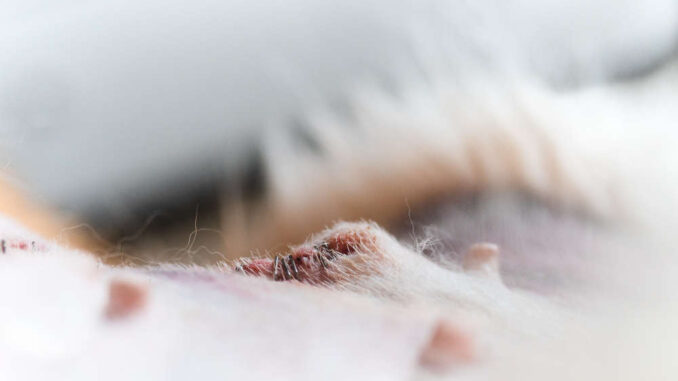
This article was updated on January 24th, 2024
Typically, after a spay or neuter surgery, dogs are seen by their veterinarian about three days after the procedure and again after 14 days. This is so we can examine them and their surgical incisions, checking for any issues such as lumps or discharge.
For the majority of pets who are neutered, there will not be any complications. However, when complications do occur, lumps forming would not be uncommon. These lumps can have a range of causes, and are always something we’d want to look into further. Let’s take a closer look at the lumps we see and the treatments advised.
Is it normal for a dog to have a lump after a spay or neuter surgery?
After surgery, we’d expect the surgical incision to be flat. There can be mild swelling in the first few days, as the tissue heals. We do sometimes see a small amount of bruising and scabbing, as the skin and muscle have been cut into and there will inevitably have been some bleeding.
Below is a photo of a spay wound after a recent surgery. We can see the external sutures, which would be removed about 10 days after the procedure. There is some pink skin and the wound looks healthy:
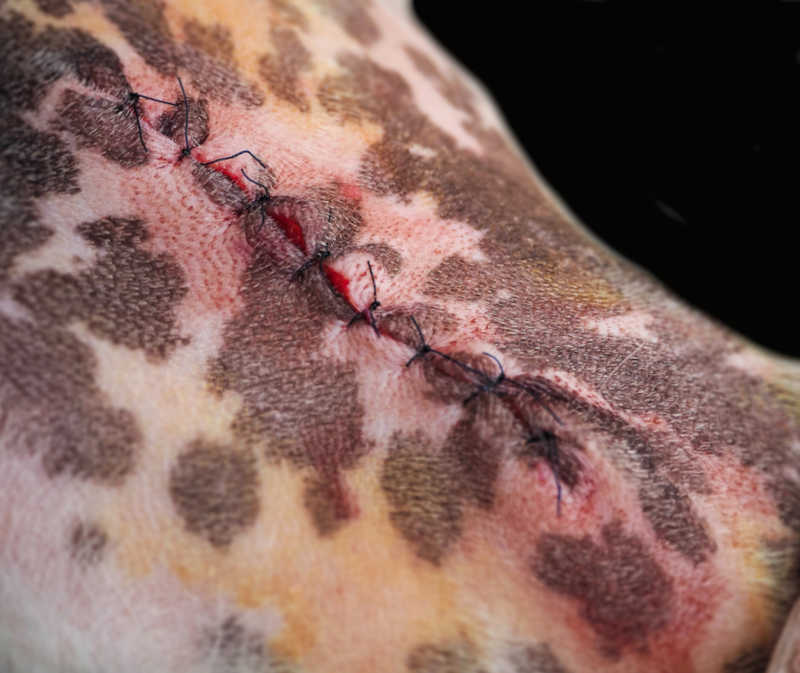
Here is a spay incision that is further along in the healing process. In this case, internal sutures have been used so no external sutures are visible:
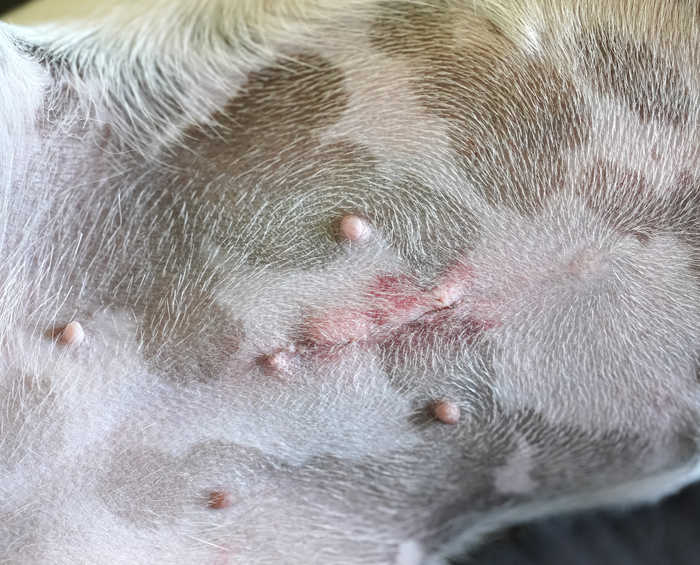
As we can see, these spay incisions are not raised and there are no bumps. If we do see a lump or swelling, this is something we want to discuss with the dog’s vet. A small firm lump at the incision site may be part of the normal healing process (‘Incision Lumps‘). However, there should be no excessive redness and no discharge and the lump should usually resolve without treatment within two weeks. An example is provided in the picture below:
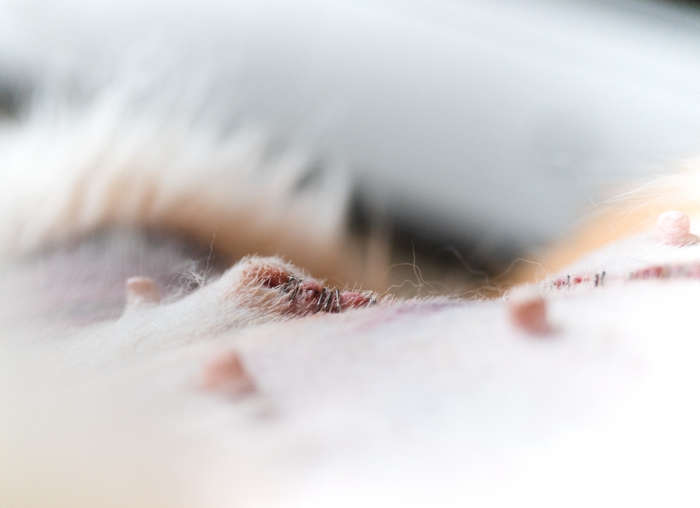
When it comes to a male recovering from their castration surgery, some swelling and bruising is expected. This is due to gravity and the fact that the scrotal sac is left behind, meaning it inevitably fills up with fluid and/or blood initially.
As we can see in the photo below, there will be some scrotal swelling and the skin can appear red and purple. Indeed, some owners wonder if their dog has been castrated at all! This is to be expected and can occur within the first 1-2 days after surgery: Picture (Warning Graphic Image)
What are the common causes of lumps after neutering incision?
• A normal post-op occurrence
Importantly, after a male is castrated, there will be swelling within their scrotal sac. This swelling occurs shortly after the surgery, and the scrotal sac can fill back to its previous size. The skin can look red or purple and is often warm to touch and uncomfortable for the dog.
As the body heals, the swelling gradually reduces without intervention. We can help reduce swelling by avoiding exercise, encouraging rest and using the anti inflammatory medicine prescribed by the vet.
• Seroma or Hematoma
A seroma is a build up of fluid within the ‘dead space’ left behind after a surgery. A hematoma is similar, but the fluid involved is blood. These swellings are not infections and most vets would not provide any treatment, instead expecting the body to deal with the swelling within a week or two, gradually reabsorbing this fluid.
Very large seromas that are causing discomfort or bothering the dog may be drained. However, they tend to refill quickly. In some cases, pressure wraps will be used to help prevent the seroma re-filling.
In some instances, when there is a hematoma, ice packs and anti-inflammatories can help. See this picture from AskAVetQuestion.com.
• Hernia
It would be rare for a dog to develop a hernia after spaying or neutering. However, as the body wall is cut into, a hernia can possibly occur, particularly if the dog is very large or the dog does not rest adequately after their procedure.
If a hernia occurs after a spay, it would be an umbilical hernia. The hernia can include fat or omentum, or even intestines. The affected bitch would require a surgery to correct the defect and repair the abdominal wall.
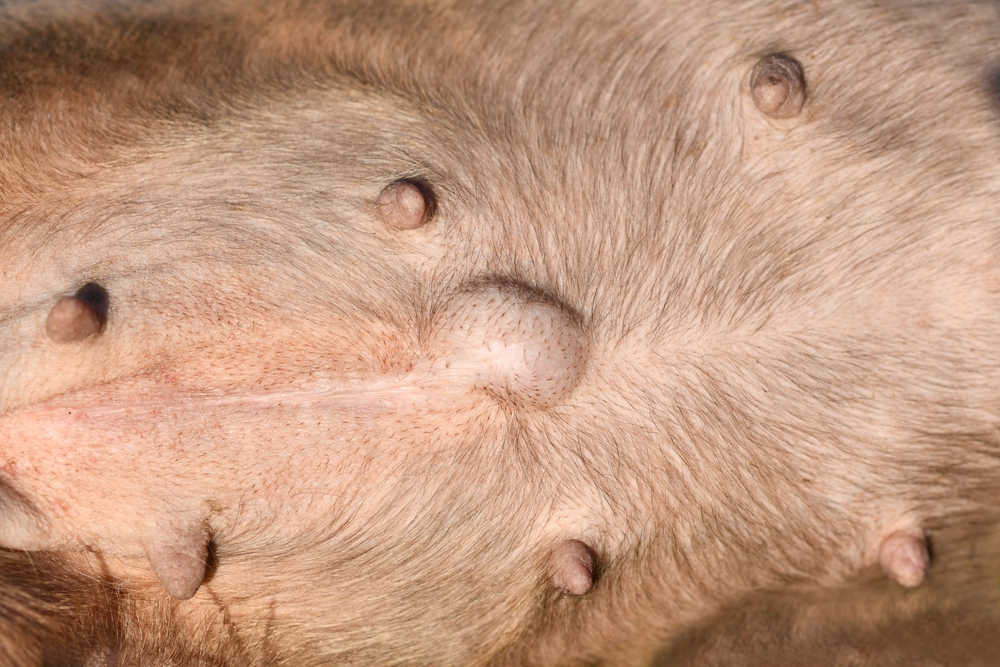
• Abscess
An abscess is an infection that can occur after any surgery, including neutering. While mild infections are common, abscesses are not seen that often. Before it ruptures, the abscess appears like any other swelling. After rupturing, we’ll see a pus-filled, bloody discharge which has a foul smell.
Some abscesses will be drained and flushed. For all patients, they’ll be prescribed antibiotics and anti inflammatory medicine to help clear the infection and keep the dog comfortable. From home, owners should clean the lesion regularly using salt water and must prevent any licking or chewing, which usually means utilizing a surgical cone.
Related posts:
Spay Incision Infections: How to Recognize the Early Signs
Infections and Complications after a Neuter Surgery
When to worry about a lump: signs of concern
Any lump that forms after a neutering surgery is something we should monitor and report to the pet’s vet. While some swelling can be expected, substantial swelling could be a sign of an infection or internal bleeding, so having a vet assess the area is always wise.
When to call the vet
It is wise to call the vet if your dog has developed a lump that is quickly expanding or causing them distress. It is equally worrying if there is blood dripping from the incision site or the dog is pale or weak, as this could indicate internal bleeding.
Signs of an infection (including heat, swelling and ooze) are all worth reporting to the vet as starting antibiotics promptly can help decrease recovery time.
What you can do at home to help
Importantly, we want to minimize movement, as this helps prevent bruising and fluid build up near the incision. On top of this, we must prevent any licking or chewing of the incision, as this can lead to wound break down and infection.
Using buster collars and surgical shirts is a great way to keep incisions clean. For dogs who are becoming obsessive over licking their wound, it helps to distract them with things like food puzzles and chews.
Surgical wounds can be kept clean with dilute Chlorhexidine or salt water and lesions are usually cleaned once or twice daily.
Owners need to stick to post-op instructions and to administer all medicine as prescribed.
If my dog has a lump, would a vet be able to help over a video call, or should I go in for an office visit?
A video call can be very helpful, yes. Vets can give you a general idea as to what is going on and will be able to advise on the best course of action from home, in that moment.
If your dog needs urgent attention (for example, if the vet is concerned for active bleeding), they would advise you see the local emergency vet right away.
Disclaimer: This website's content is not a substitute for veterinary care. Always consult with your veterinarian for healthcare decisions. Read More.


Be the first to comment